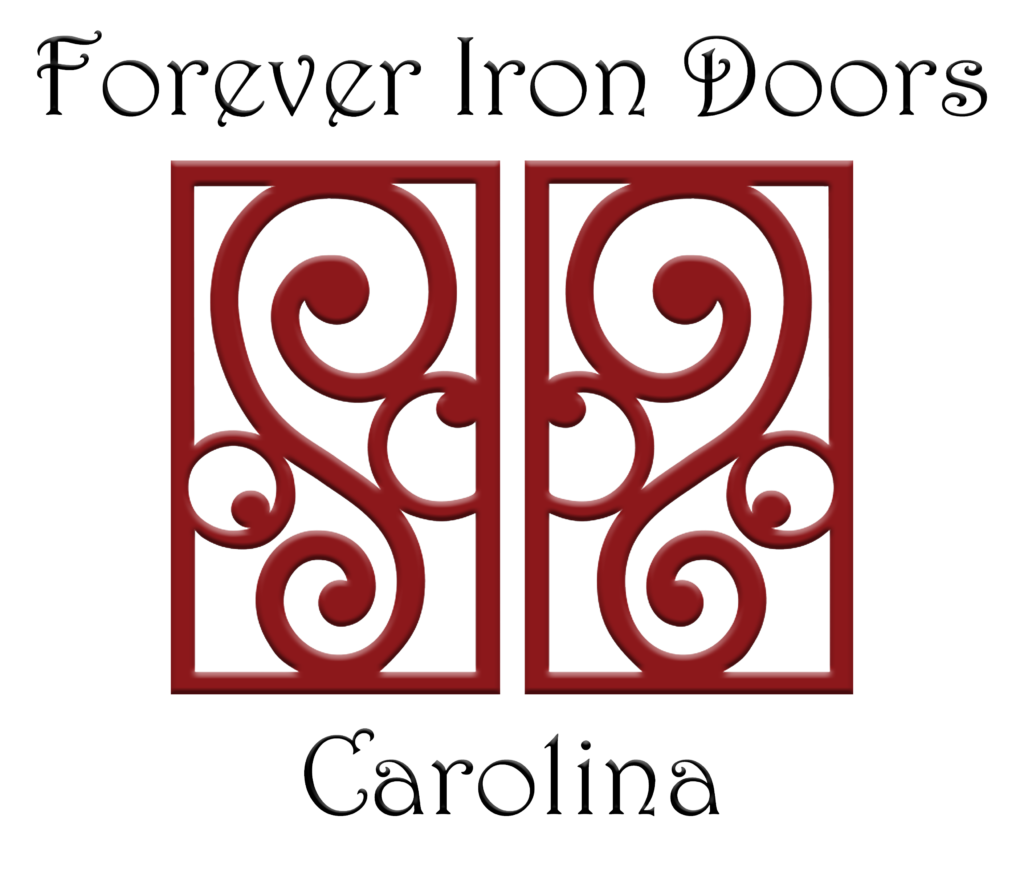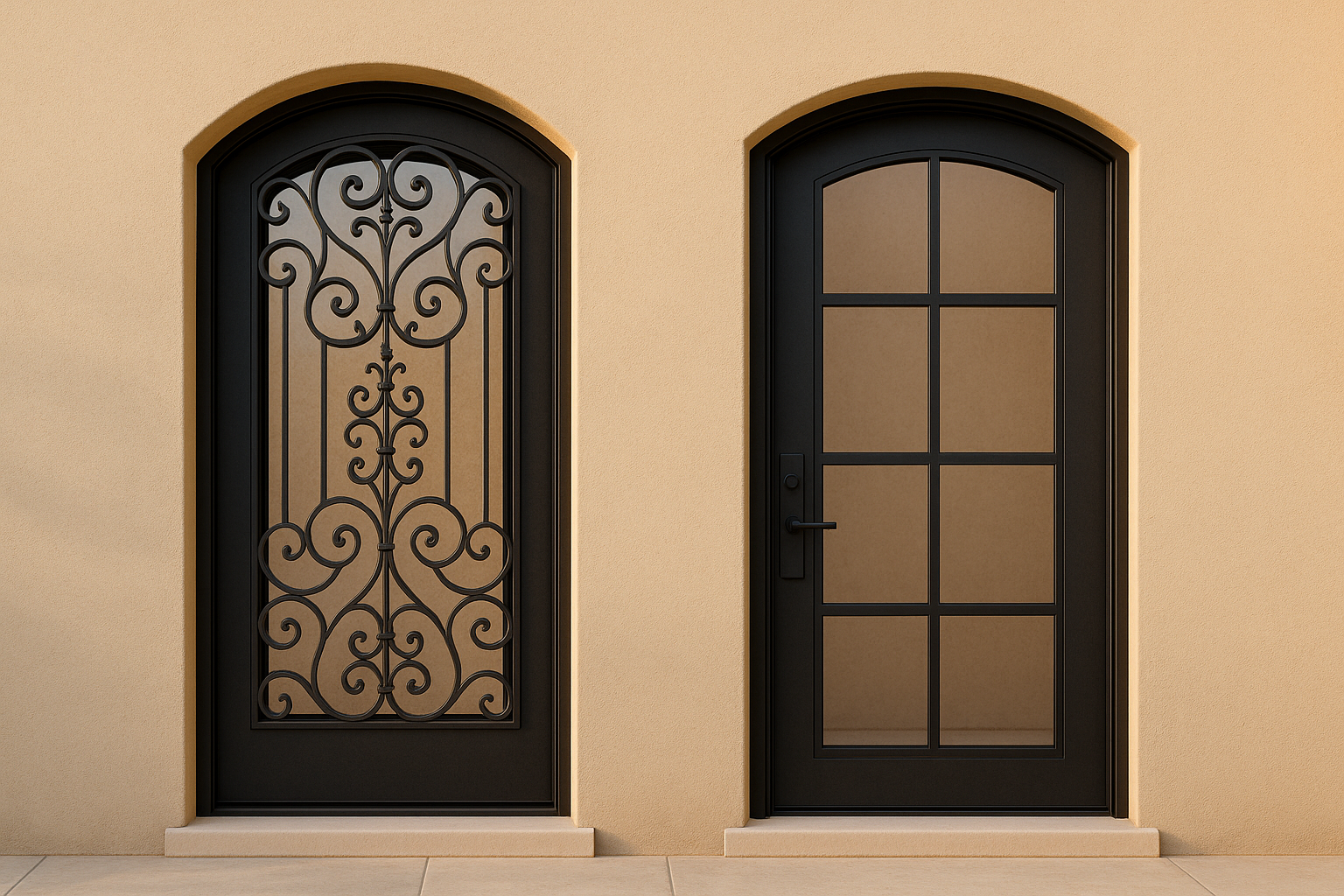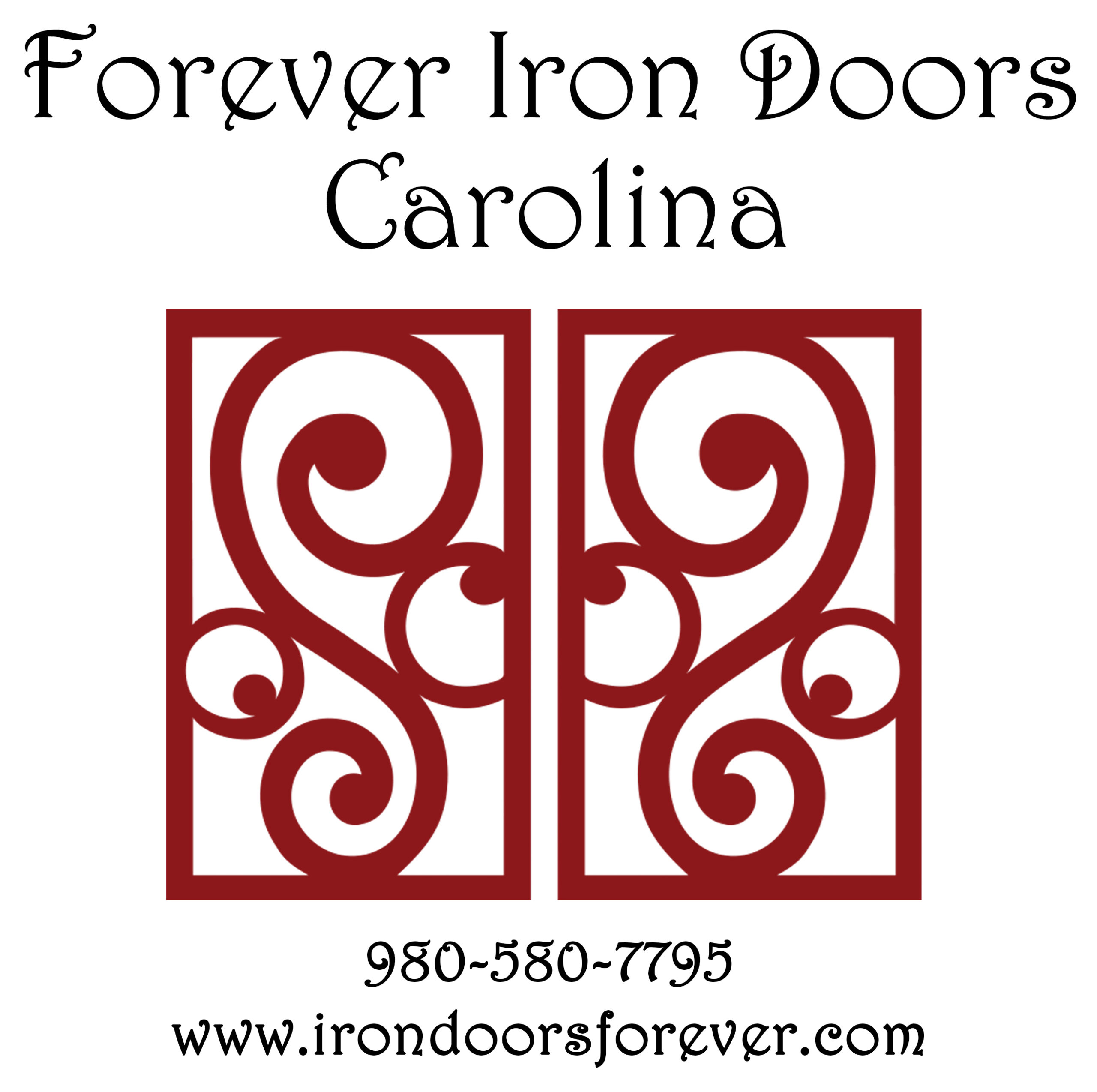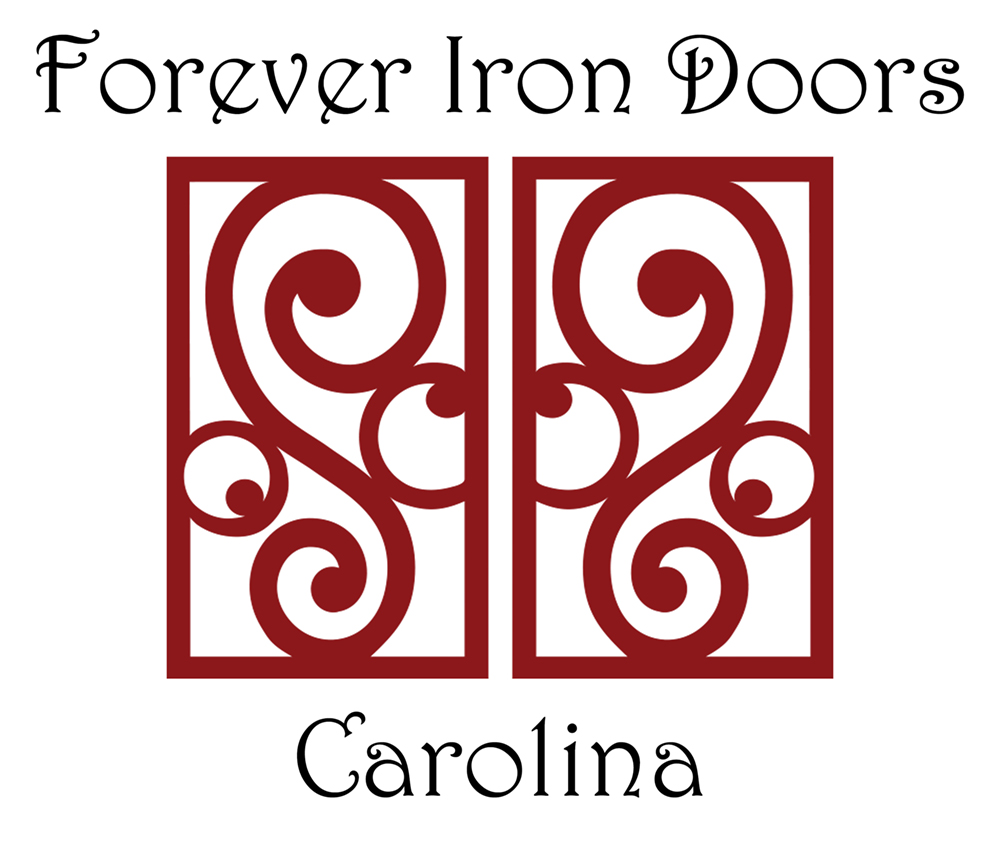Wrought iron doors are a popular choice for homeowners due to their durability, security, and design appeal. The decision between modern and traditional styles primarily depends on your home’s architectural style and personal preferences. Here’s a quick breakdown:
- Modern Wrought Iron Doors: Focus on clean lines, geometric patterns, and minimal designs. Commonly feature matte black or brushed steel finishes and clear glass for a sleek, contemporary look. Ideal for modern, industrial, or mid-century homes.
- Traditional Wrought Iron Doors: Highlight ornate scrollwork, curved designs, and decorative glass options like frosted or textured. Often paired with distressed or aged finishes, making them a great fit for Colonial, Victorian, or Mediterranean homes.
Quick Comparison Table:
| Feature | Modern Doors | Traditional Doors |
|---|---|---|
| Design Style | Minimal, geometric patterns | Ornate, detailed craftsmanship |
| Finish Options | Matte black, brushed steel | Distressed, aged textures |
| Glass Type | Clear or low-iron glass | Frosted, rain, or textured glass |
| Best For | Contemporary, industrial homes | Colonial, Victorian, Mediterranean |
| Security Features | Smart locks, multi-point systems | Heavy construction, solid materials |
| Energy Efficiency | Insulated cores, advanced weather seals | Basic insulation, thicker steel |
Both styles offer excellent security and long-lasting construction, with modern doors excelling in energy efficiency and low maintenance. Your choice should align with your home’s architecture and desired aesthetic.
Design Characteristics: Modern vs. Traditional Wrought Iron Doors
The differences between modern and traditional wrought iron doors are unmistakable, with each style offering a unique visual appeal that can dramatically influence the look of your home’s entrance. Understanding these design features can help you select a door that aligns perfectly with both your home’s architecture and your personal taste. This discussion sets the foundation for a closer look at materials and performance in later sections.
Traditional Wrought Iron Door Design
Traditional wrought iron doors are all about intricate craftsmanship and timeless elegance, often featuring ornate scrollwork and detailed patterns that evoke a sense of history. These designs draw inspiration from European, Mediterranean, and Spanish architectural styles, offering a handcrafted quality that reflects centuries of metalworking traditions.
The surfaces of traditional doors often showcase distressed or textured iron, giving them an aged, weathered look. Paired with decorative glass options, such as frosted, rain, or textured glass, these doors provide both privacy and a touch of sophistication. The addition of intentional patina enhances their character, making each door feel like a piece of art. Color choices typically lean toward classic tones that highlight the vintage aesthetic, perfectly complementing traditional home designs.
These doors are particularly fitting for Colonial and Victorian homes, where their detailed scrollwork and elegant designs harmonize with the architectural nuances of these styles. They also blend seamlessly with Mediterranean and Spanish-inspired homes, where their bold and intricate designs enhance the overall aesthetic.
Modern Wrought Iron Door Design
Modern wrought iron doors take a completely different approach, focusing on clean lines and geometric precision for a minimalist, contemporary look. These designs emphasize simplicity, stripping away elaborate details to highlight the beauty of the material and the precision of modern fabrication techniques.
Finishes for modern doors typically include matte black or brushed steel, creating a sleek and polished appearance. These understated finishes allow the door to stand out as a striking feature without dominating the overall design. The result is a cutting-edge look that aligns with modern design principles.
Glass choices in modern doors prioritize natural light and openness. Clear or low-iron glass panels are commonly used to foster a sense of transparency and connection between indoor and outdoor spaces. This design approach aligns with the modern architectural focus on light, space, and seamless integration with the environment.
Modern wrought iron doors are ideal for contemporary, industrial, minimalist, and mid-century modern homes, where their clean lines and geometric forms enhance the architectural focus on functionality and simplicity. The streamlined design complements homes that value uncluttered spaces and modern aesthetics.
Visual Comparison Table
| Design Element | Traditional Wrought Iron Doors | Modern Wrought Iron Doors |
|---|---|---|
| Ornamentation | Elaborate scrollwork, intricate patterns, artisanal feel | Minimal details, bold geometric shapes, simplicity |
| Line Style | Curved, detailed, classic | Straight, clean, streamlined |
| Finish/Color Palette | Distressed textures, aged finishes | Matte black, brushed steel, neutral tones |
| Glass Type | Decorative, frosted, or textured for privacy and elegance | Clear or low-iron for openness and natural light |
| Overall Appeal | Historical charm, old-world craftsmanship | Sleek, modern, and minimalist |
Choosing between these two design styles comes down to your home’s architecture and your personal preferences. Traditional designs emphasize historical charm and intricate craftsmanship, while modern designs focus on simplicity and a forward-thinking aesthetic. Next, we’ll dive into the materials and construction that set these doors apart.
Material and Construction Differences
Wrought iron doors differ significantly in their materials and construction methods, which directly impact their look, durability, and cost. While both modern and traditional styles use similar base materials, the way these materials are processed and assembled creates distinct differences in performance and aesthetic appeal.
Core Materials and Durability
The foundation for both modern and traditional wrought iron doors is typically steel, but the type and treatment of the steel can vary. True wrought iron, known for its low carbon content and hand-forged craftsmanship, is rarely used today due to its high cost and limited availability. Instead, most doors marketed as "wrought iron" today are made from mild steel or low-carbon steel, which offers excellent strength and is easier to work with.
Traditional wrought iron doors often use 12–14 gauge steel, which is thicker and heavier, making it ideal for supporting intricate scrollwork and decorative elements. To enhance rust resistance, the steel may undergo hot-dip galvanizing, which coats it with a layer of zinc at the molecular level, offering long-term protection against corrosion.
Modern wrought iron doors, on the other hand, typically use 16–18 gauge steel, which is lighter but still durable. These doors rely on advanced welding techniques and precision engineering to distribute stress effectively, allowing for thinner materials without compromising strength.
Both traditional and modern styles benefit from powder coating finishes, which are far more durable than traditional paint. This finish creates a smooth, chip-resistant surface that can last 15 to 20 years, protecting the doors from wear and the elements.
Fabrication Techniques
The fabrication methods used for traditional and modern wrought iron doors further set them apart. Traditional doors often feature hand-forged elements crafted by skilled artisans using hammers, anvils, and specialized tools. This process results in subtle variations and character marks that highlight the handmade quality of the design. Arc and gas welding techniques are commonly used, leaving visible welds that complement the handcrafted aesthetic. In some cases, mortise and tenon joints, reminiscent of traditional woodworking, are incorporated to enhance the design’s authenticity.
Modern wrought iron doors, by contrast, rely on precision machinery and cutting-edge technology to achieve sleek, geometric designs. Tools like plasma cutters and laser cutters produce clean, precise edges and consistent angles. TIG welding is often used to create nearly invisible seams, which are then ground flush and polished for a flawless appearance. These modern techniques also allow for extensive customization, enabling intricate and highly detailed designs.
Customization Options
Forever Iron Doors Carolina offers a wide range of customization options by combining advanced fabrication techniques with diverse material choices. For instance, glass integration options range from clear tempered glass for maximum light to decorative art glass with etched patterns or colored accents, catering to both traditional and modern styles.
Hardware and finishes can also be tailored to match the desired aesthetic. Traditional doors may feature wrought iron handles and decorative hinges, while modern designs often incorporate stainless steel or powder-coated aluminum components. Additional texture options, such as hammered finishes or specialty coatings in bronze, copper, or brushed steel, are achieved through specialized powder coating techniques, enhancing either the classic or contemporary feel.
Thanks to their in-house fabrication capabilities, the company can accommodate custom sizing for non-standard openings, integrate security features, and provide specialized glass treatments for added privacy or energy efficiency. Their design team works closely with homeowners to craft doors that suit the specific climate conditions of North and South Carolina while meeting individual style preferences and architectural needs.
Functional Features and Performance
Building on the materials and methods discussed earlier, these functional features show how design choices directly influence performance. Wrought iron doors aren’t just visually striking – they also offer practical advantages that homeowners can appreciate. The differences between modern and traditional designs come into sharp focus when examining their security, energy efficiency, and maintenance needs.
Security Features
When it comes to security, both modern and traditional wrought iron doors excel, thanks to the natural strength of iron. This material resists forced entry, extreme weather, and even water infiltration, creating a nearly impenetrable barrier. A single wrought iron door can weigh over 400 pounds, while double doors can tip the scales at more than 1,000 pounds. That kind of heft makes them a strong deterrent, especially considering that over 80% of break-ins occur through the front or first-floor door. Traditional designs rely on the sheer strength of the material and solid craftsmanship to provide dependable security.
Modern wrought iron doors, however, raise the bar with advanced security features. These include multi-point locking systems, smart lock compatibility, and reinforced strike plates, which secure the door at multiple points. Precision manufacturing also ensures tighter fits between the door and its frame, minimizing weak spots.
Energy Efficiency
Energy efficiency is another area where modern doors stand apart from their traditional counterparts. While traditional wrought iron doors are secure, their solid iron construction can easily conduct heat and cold, leading to higher energy costs in extreme climates.
Modern designs tackle this issue with innovative features aimed at improving thermal performance. Insulated cores help reduce heat transfer, while advanced weather stripping seals the door tightly to prevent air leaks. Energy-efficient glass options further enhance insulation without compromising the door’s aesthetic appeal.
In regions like North and South Carolina, where summers are hot and humid and winters can be unpredictable, these energy-saving features can make a noticeable difference in utility bills. Over time, these improvements also reduce the strain on heating and cooling systems, adding to the door’s long-term value.
Maintenance and Longevity
Maintenance needs differ significantly between traditional and modern wrought iron doors, largely due to advances in finishes and construction techniques. Traditional doors often require more upkeep to prevent rust and maintain their appearance, especially in coastal areas where salt air accelerates corrosion.
Modern doors benefit from advanced protective finishes, such as powder coating applied through electrostatic processes. This ensures even coverage, even in intricate designs, and significantly reduces maintenance. Regular cleaning and occasional touch-ups for chips or scratches are usually all that’s needed to keep them looking their best.
Additionally, the hot-dip galvanizing process provides an extra layer of rust protection, creating a solid base for the powder coating. This combination offers far better durability compared to traditional paint finishes.
Performance Comparison Table
Here’s a quick look at how traditional and modern wrought iron doors compare:
| Feature | Traditional Wrought Iron Doors | Modern Wrought Iron Doors |
|---|---|---|
| Security Level | Excellent – Strong material and heavy construction | Excellent – Enhanced with advanced locking systems |
| Energy Efficiency | Basic insulation; limited thermal performance | Superior insulation with advanced cores and weather seals |
| Maintenance | Requires regular upkeep to prevent rust | Minimal upkeep due to advanced finishes and coatings |
| Weather Resistance | Good – Galvanizing and powder coating provide durability | Excellent – Precision seals and improved coatings |
Modern wrought iron doors shine in areas with challenging climates, like North and South Carolina. With high humidity, fluctuating temperatures, and occasional severe weather, these doors maintain their functionality and appearance over time. Forever Iron Doors Carolina combines traditional craftsmanship with modern technology to deliver doors that excel in security, energy efficiency, and low maintenance for these demanding conditions.
sbb-itb-cd90297
Choosing the Right Style for Your Home
When it comes to selecting the perfect door, it’s not just about functionality – it’s about complementing your home’s architecture. The right door can elevate your home’s curb appeal and seamlessly tie into its overall design. Here’s a guide to help you match your door style to your home’s unique character.
Matching Door Style to Home Architecture
Your home’s architectural style is the best starting point for choosing between modern and traditional wrought iron doors. Whether your home leans toward Classic, Mediterranean, Modern, Farmhouse, or Ranch aesthetics, here’s a quick reference to guide your decision:
| Architectural Style | Recommended Iron Door Features |
|---|---|
| Classic (Colonial, Victorian) | Ornate scrollwork, decorative patterns, curved designs |
| Mediterranean & Spanish | Bold designs, vibrant finishes, linear patterns |
| Modern & Contemporary | Minimalist design, geometric patterns, matte black finish |
| Farmhouse & Cottage | Glass panels, rustic patterns, warm finishes |
| Ranch-Style | Clean lines, large glass panels, bronze or weathered finishes |
Key Considerations for Homeowners
Beyond matching your home’s architecture, think about the statement your door makes. It’s the first thing visitors see, so consider custom touches like unique handles, intricate patterns, or personalized motifs that reflect your style while staying true to your home’s design.
Pay attention to finishes, especially if you live in areas like North and South Carolina where humidity can be a factor. A durable, weather-resistant finish not only enhances the door’s appearance but also protects it from the elements, ensuring it remains beautiful and functional over time.
Expertise from Forever Iron Doors Carolina
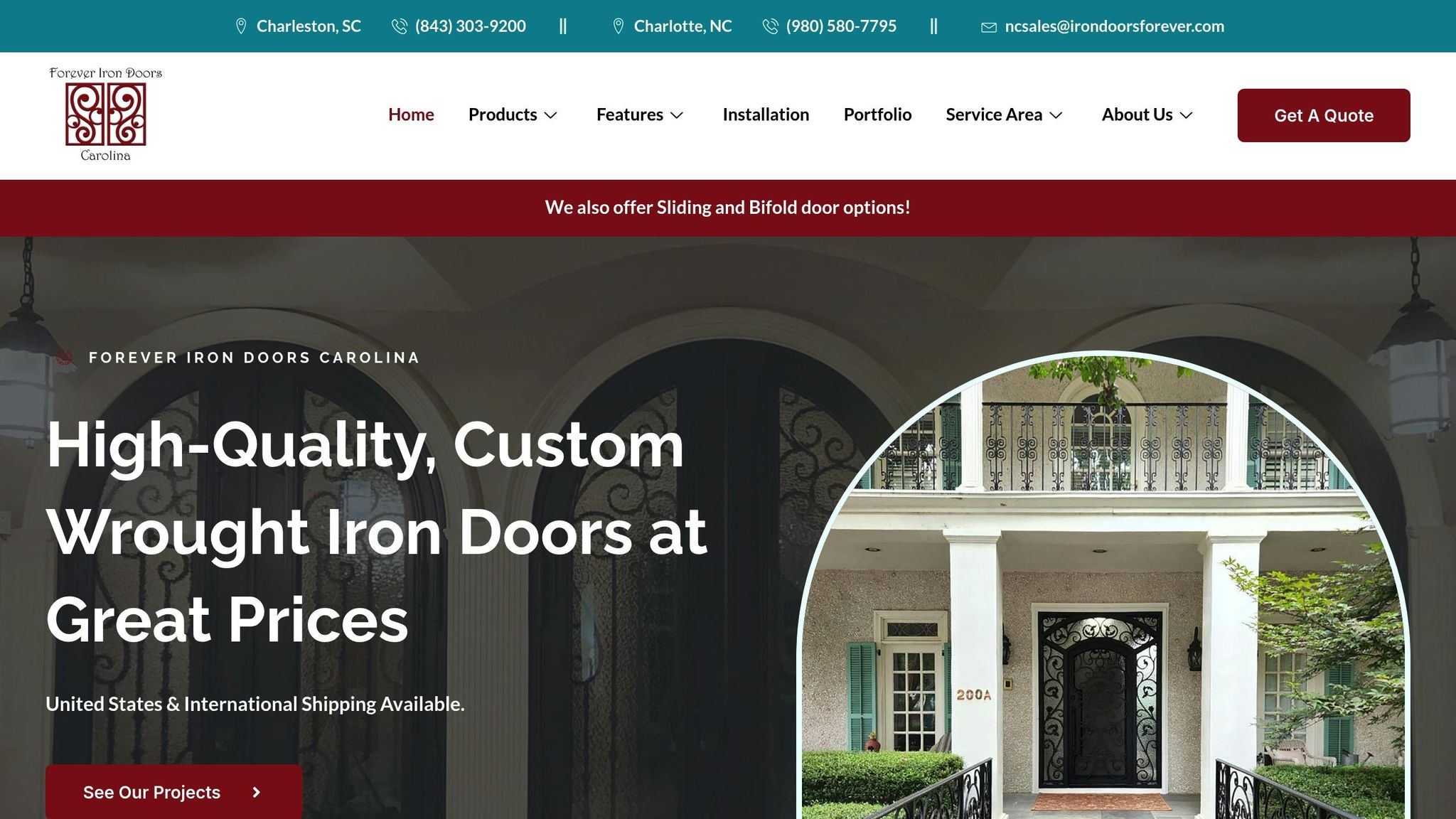
For homeowners seeking a blend of elegance and practicality, Forever Iron Doors Carolina offers tailored solutions. Their team specializes in creating custom designs that align perfectly with your home’s architecture, whether you’re looking for intricate details for a historic property or sleek lines for a modern aesthetic.
They provide options for glass customization, weather-resistant finishes, and hardware that can be personalized to your liking. Plus, their professional installation ensures your door fits perfectly and is sealed properly, which is crucial for both security and energy efficiency – especially in the Carolinas’ challenging climate.
With local expertise, they help you choose a door that not only complements your home’s style but also stands up to regional weather conditions, enhancing both its beauty and performance.
Conclusion
When it comes to choosing between modern and traditional wrought iron doors, the decision largely depends on your personal style and how well the design complements your home’s architecture. Traditional designs bring intricate details and timeless craftsmanship, making them a great match for Colonial, Victorian, or Mediterranean homes. On the other hand, modern styles lean toward clean lines and geometric patterns, perfectly suited for contemporary or farmhouse aesthetics.
Both styles are built to last, thanks to advanced steel processing and protective coatings. They also hold up equally well in terms of security, energy efficiency, and maintenance. Ultimately, your choice boils down to which design resonates with your taste and fits your home’s character.
Explore Custom Designs with Forever Iron Doors Carolina
If you’re looking for something that truly reflects your vision, Forever Iron Doors Carolina offers tailored solutions to create a door that’s as unique as your home. Their services include custom glass designs, specialized finishes, and personalized hardware to ensure your entrance stands out.
With expert installation and an understanding of the Carolinas’ weather challenges, they deliver doors that combine beauty with long-lasting performance. A custom wrought iron door isn’t just an upgrade – it’s an investment in your home’s security and curb appeal that will stand the test of time.
FAQs
What should I consider when deciding between modern and traditional wrought iron doors for my home?
When deciding between modern and traditional wrought iron doors, you’ll want to weigh factors like design style, materials, and functionality. Traditional wrought iron doors often showcase detailed, handcrafted designs with a timeless, elegant appeal, making them a great match for homes with rustic or vintage themes. In contrast, modern wrought iron doors emphasize sleek lines and minimalistic aesthetics, frequently featuring upgrades like better insulation and advanced locking systems – perfect for a contemporary look.
You should also consider durability, security, and customization options. Both options can be personalized with various glass styles, finishes, and hardware to suit your preferences. The best choice will not only enhance your home’s architectural style but also provide the safety and durability you need.
What makes modern wrought iron doors more energy-efficient than traditional designs?
Modern wrought iron doors are built with cutting-edge materials and features that help improve energy efficiency. Many of these doors are equipped with insulated cores, such as polyurethane foam, which work to limit heat transfer between your home’s interior and the outdoors. On top of that, some designs incorporate thermal breaks within the iron framework, adding an extra layer of protection against heat loss or gain.
Another standout feature is the inclusion of insulated glass panels. These panels help maintain a consistent indoor temperature by blocking drafts and minimizing energy loss. Together, these advancements not only keep your home comfortable throughout the year but can also contribute to lower energy costs in the long run.
What are the customization options for wrought iron doors to suit different home styles?
Wrought iron doors provide plenty of ways to make them fit perfectly with different architectural styles. Whether you prefer detailed scrollwork for a more traditional vibe, sleek geometric designs for a modern touch, or decorative glass panels to add a bit of elegance, there’s something to suit every taste.
You can also customize with a variety of finishes, colors, and hardware to match your home’s design – be it classic, contemporary, or even coastal. These choices not only boost your home’s curb appeal but also ensure the door complements the overall aesthetic seamlessly.
